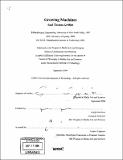| dc.contributor.advisor | Joseph Jacobson. | en_US |
| dc.contributor.author | Griffith, Saul Thomas, 1974- | en_US |
| dc.contributor.other | Massachusetts Institute of Technology. Dept. of Architecture. Program in Media Arts and Sciences. | en_US |
| dc.date.accessioned | 2005-09-27T18:18:10Z | |
| dc.date.available | 2005-09-27T18:18:10Z | |
| dc.date.copyright | 2004 | en_US |
| dc.date.issued | 2004 | en_US |
| dc.identifier.uri | http://hdl.handle.net/1721.1/28780 | |
| dc.description | Thesis (Ph. D.)--Massachusetts Institute of Technology, School of Architecture and Planning, Program in Media Arts and Sciences, 2004. | en_US |
| dc.description | Includes bibliographical references. | en_US |
| dc.description.abstract | construction is developed in three dimensions. It is similarly shown that right-angled tetrahedrons, when folded from an edge-connected string, can generate any three dimensional structure where the primitive pixel (or voxel) is a rhombic hexahedron. This construction also suggests a concept of 3D completeness for assembly, somewhat analogous to the concept of Turing completeness in computation. In combination, these pieces of work suggest that a manufacturing system based on four tiles, with seven states per tile, is capable of self-replication of arbitrary 3D structure by copying, then folding, bit strings of those tiles where the desired structure is encoded in the tile sequence. | en_US |
| dc.description.abstract | Biological systems are replete with examples of high complexity structures that have "self assembled," or more accurately, programmatically assembled from many smaller, simpler components. By comparison, the fabrication systems engineered by humans are typically top down, or subtractive, processes where systems of limited complexity are carved from bulk materials. Self-assembly to date has resembled crystallization more than it has the programmatic assembly of complex or useful structures--these systems are information limited. This thesis explores the programming of self-assembling systems by the introduction of small amounts of state to the sub-units of the assembly. A six-state, kinematic, conformational latching component is presented that is capable of self-replicating bit strings of two shape differentiated versions of the same component where the two variants represent the 0 and 1 bits. Individual units do not assemble until a string is introduced to the assembly environment to be copied. Electro-mechanical state machine emulators were constructed. Operating on an air table, the units demonstrated logic limited aggregation, or error-preventing assembly, as well as autonomous self-replication of bit strings. A new construction was developed that demonstrates that any two dimensional shape composed of square pixels can be deterministically folded from a linear string of vertex-connected square tiles. This non-intersecting series of folds implies a 'resolution' limit of four tiles per pixel. It is shown that four types of tiles, patterned magnetically, is sufficient to construct any shape given sequential folding. The construction was implemented to fold the letters 'M I T' from sequences of the 4 tile types. An analogous | en_US |
| dc.description.statementofresponsibility | Saul Thomas Griffith. | en_US |
| dc.format.extent | 113 leaves | en_US |
| dc.format.extent | 6454194 bytes | |
| dc.format.extent | 6469041 bytes | |
| dc.format.mimetype | application/pdf | |
| dc.format.mimetype | application/pdf | |
| dc.language.iso | en_US | |
| dc.publisher | Massachusetts Institute of Technology | en_US |
| dc.rights | M.I.T. theses are protected by copyright. They may be viewed from this source for any purpose, but reproduction or distribution in any format is prohibited without written permission. See provided URL for inquiries about permission. | en_US |
| dc.rights.uri | http://dspace.mit.edu/handle/1721.1/7582 | |
| dc.subject | Architecture. Program in Media Arts and Sciences. | en_US |
| dc.title | Growing machines | en_US |
| dc.type | Thesis | en_US |
| dc.description.degree | Ph.D. | en_US |
| dc.contributor.department | Program in Media Arts and Sciences (Massachusetts Institute of Technology) | |
| dc.identifier.oclc | 60129661 | en_US |
